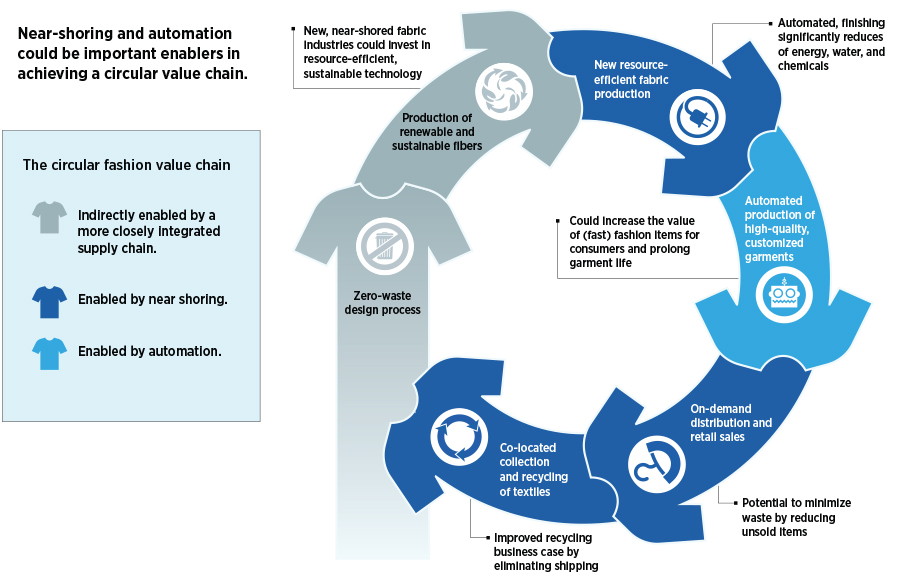How Circular Marketing Brings Hope

In Chile’s Atacama Desert, more than 100,000 tons of clothing, including never-worn pieces with sales tags still attached, lie in heaps that stretch for miles.
“It’s not a landfill,” Alexis Carreno, the dumpsite owner, told Bloomberg last year. Oh? What is it, then?
It’s a striking visual portrait of fast fashion’s impact on the environment, a landscape painted with mounds of tops and bottoms and other apparel that didn’t make it in the marketplace or last very long in someone’s wardrobe.
Despite such eyesore expanses, an increasing number of businesses are making efforts to decrease their commercial and industrial carbon footprints a core part of their operations. Others, however, flagrantly ignore any attempt at sustainability. And so do some consumers of fast fashion.
That fabric-filled stretch of Chilean desert symbolizes the seemingly endless stream of refuse piling up after decades of wasteful, negligent practices of industries in every sector, but most notably in fashion, where quick-and-cheap demand has been rising rapidly for about two decades.
It’s conspicuous consumption, but not exactly what American economist Thorstein Veblen was seeing when he coined the phrase in 1899. Then, Veblen referred to consumers who flaunted their wealth by purchasing high-quality, expensive goods. Fast fashion flips that idea: people — disproportionally young women — chase every trend for status points, and it’s quantity, not quality, that matters.
There is no magical solution to the ecological downside of fast fashion, which has been on a wild ride since around 2008, when the business model collided with the explosion of social media and millions of influencers producing “haul” photo shoots and videos spotlighting their trendy — and cheap — finds to eager young women.

The circular way
But sustainability experts see a glimmer of hope via the circular marketing model, which propels and encourages sustainability by focusing on keeping, recycling and reusing well-made items.
Harbert alum Connie Berardinelli spent two years in a leadership position at Trove, a California-based company that takes back merchandise from major apparel brands, prepares it for resale and ships it to new buyers, in the label’s own packaging, at discounts from 40% to 50%.
Through Trove, customers of sustainability-driven companies, including Levi’s, REI, Patagonia and Lululemon, can trade in their used items in-store or by mail, and second-hand shoppers can purchase those items online for a fraction of the original retail price.
On a Harbert Podcast titled “Saving the Planet in Retail,” Berardinelli, now the growth and strategic partnerships manager at Instacart, said circular shopping keeps items in use for longer periods, ensuring that items get into a “next best use” position that benefits the environment.
“The idea of circular selling is, first, when you need something, you really think about what it is and what the purpose of it is and how you’re going to buy it,” Berardinelli said. “Can it be bought used, instead of promoting overconsumption? Or if you already have something in your closet but want the latest color, could you trade it in and then buy the new item?”
She said the circular economy targets brands — not the consumer — “to tap into their own network, to get customers to think differently.” Once brands latch onto that way of thinking, customers become smarter shoppers, buying well-sourced, high-quality items that will have a far longer lifespan.
For example, Arc’teryx manufactures expensive outdoor jackets that “last forever,” she said. “So you’re being able to enter that price point on something that you may not have been able to afford because it has been pre-worn. It’s still an incredible product.”
Berardinelli, who earned a degree in business administration management with a concentration on
entrepreneurship and a minor in sustainable studies, is optimistic about the future of sustainability in the fashion industry. She said circular selling allows brands to have a new business in which they continue to make money on their clothing after the initial sale. Consumers begin to shop smarter. Production and design departments face less pressure on sourcing items, even all the way down to the places where the raw materials for the fabric are found.
The culprit
Fast fashion companies are the antithesis to sustainability models. They are the breeding ground for vast clothing dumps around the world. One of the largest, fastest growing of these companies is the China-based Shein, founded in 2008 by Chris Xu, who is now its CEO.
Xu has boasted that the company adds an astounding 700,000 new clothing items to its online shop every day. According to CNN, by November 2021, the company was valued at $30 billion, and it reportedly made $10 billion in revenue during the pandemic in 2020. From 2014
to 2020, it experienced sales growth of 100% each year.
In 2018, Shein, which has always been opaque about its operations, sourcing and manufacturing details, began to develop its own supply chain system. As with its compatriots — including Zara, Primark, H&M, Forever 21 and countless others — the company’s practices fly in the face of sustainability. But there is a flock of shoppers eager to get their hands on all that merchandise.
The hype
It’s mid-February 2022, and 33-year-old social media influencer Kerina pops onto YouTube, sporting an
electric blue turtleneck, polyester blazer, faux leather shorts and platform boots, arms full of enormous
packages. She embarks on her weekly “Shein haul,” trying on more than 25 pieces of clothing that she regularly orders from the company.
She’s pretty, 5’7″ and her clothing size is extra-small. As she tries on the garments, she rattles off discount prices. She says one outfit gives her “major Chanel vibes, even though this probably costs, like, one ten-thousandth of the Chanel outfit.” There are links to every Shein
product she shows, and she offers viewers a 15% discount. Even though the video is not sponsored by Shein.
Kerina is only a mid-level influencer, with about 300,000 YouTube followers (and similar numbers on Instagram), but in four days, that haul video will have amassed nearly 100,000 views.
She deems most of the purchases must-haves. As far as the rest, Shein, like other fast fashion outlets, has a nearly effortless return policy. Fast-forward to hills of clothing in the Chilean desert.
The turnaround
Amid this blizzard of buying, however, are some signs that the fast-fashion frenzy may be starting to wane. That trend is beginning to gain speed thanks to broader information and understanding of fast fashion’s impact. On TikTok, a favorite social media platform among Gen Z, video hashtags including #sustainablefashiontips have garnered more than 8 million views. A search for “sustainable clothing brands” yields pages of clips introducing viewers to environmentally responsible brands such as Kotn, Tentree, Pact, Emily Levine, Lacausa and hundreds of others.
Trends like this have increased awareness of opportunities to buy sustainably.
The website goodonyou.eco rates brands on their social and environmental impact. Another site,
sustainablejungle.com, is like a handbook for those new to sustainable shopping, guiding them to thrift sites including thredUP, Swap, Tradesy, Refashioner, The Real, Luxury Garage Sale and, of course, eBay. Quality goods, circulating for as long as possible.
Just a few years ago, people in the fashion sustainability industry would talk about circular selling and marketing in theoretical and abstract terms, Berardinelli said.
Now, people are making statements like “I committed to my board that within five years I’m going to take back 20% of the items I produce every year.”
And they’re following up on the commitment.
“The industry and the customers are paying attention to what brands are doing, where things come from,” she said. “They’re already second-guessing and questioning what they are buying and where it came from.
“We want to see a world where brands are producing smarter products that are lasting longer and paying their people and sourcing more effectively because they have this circular economy, a regenerative business model that is taking the pressure off their main line.”
—Teri Greene

